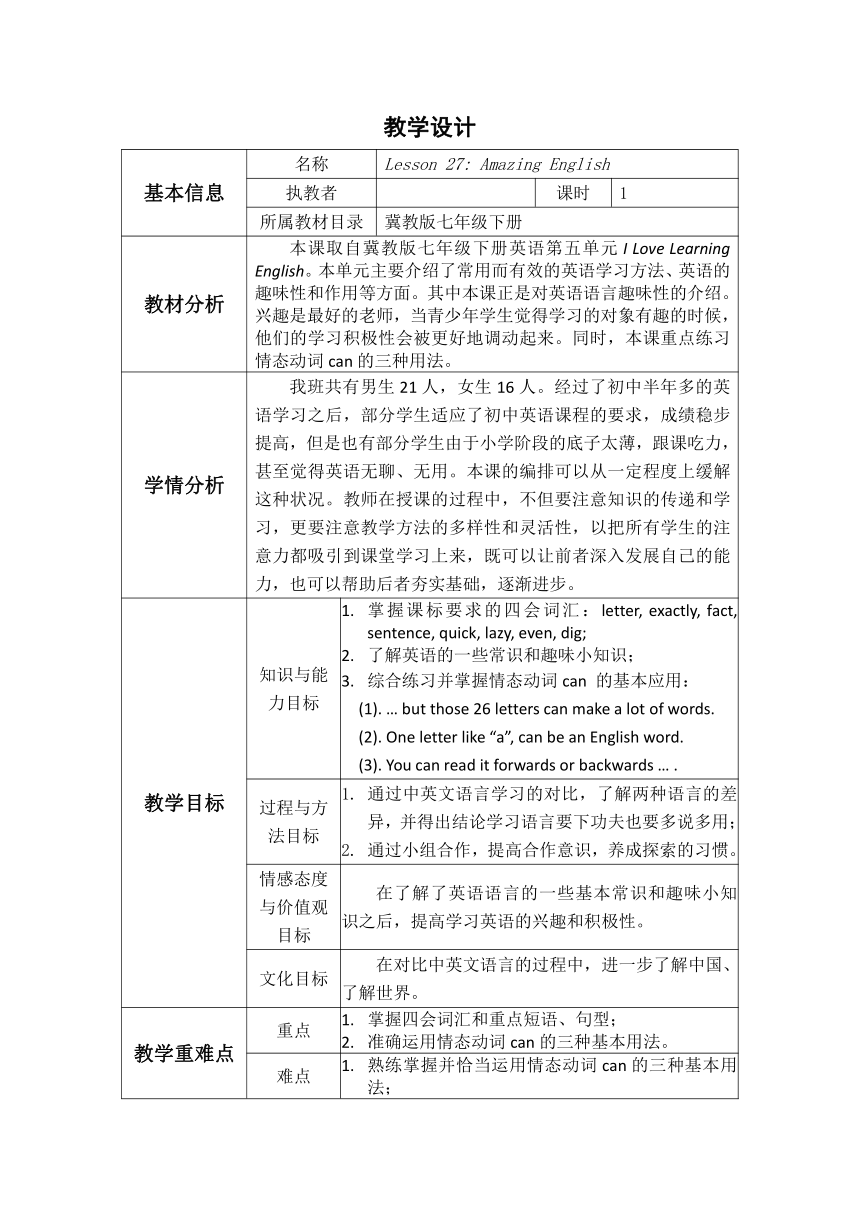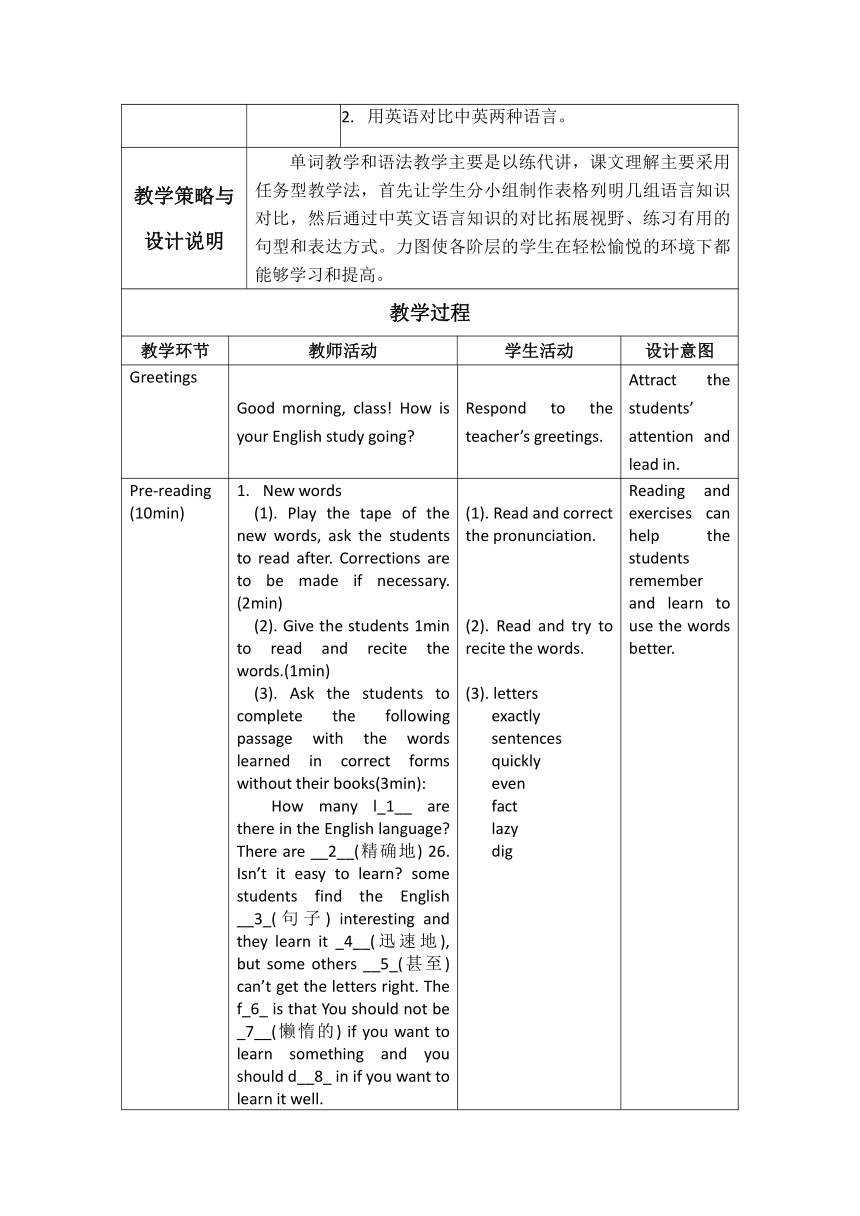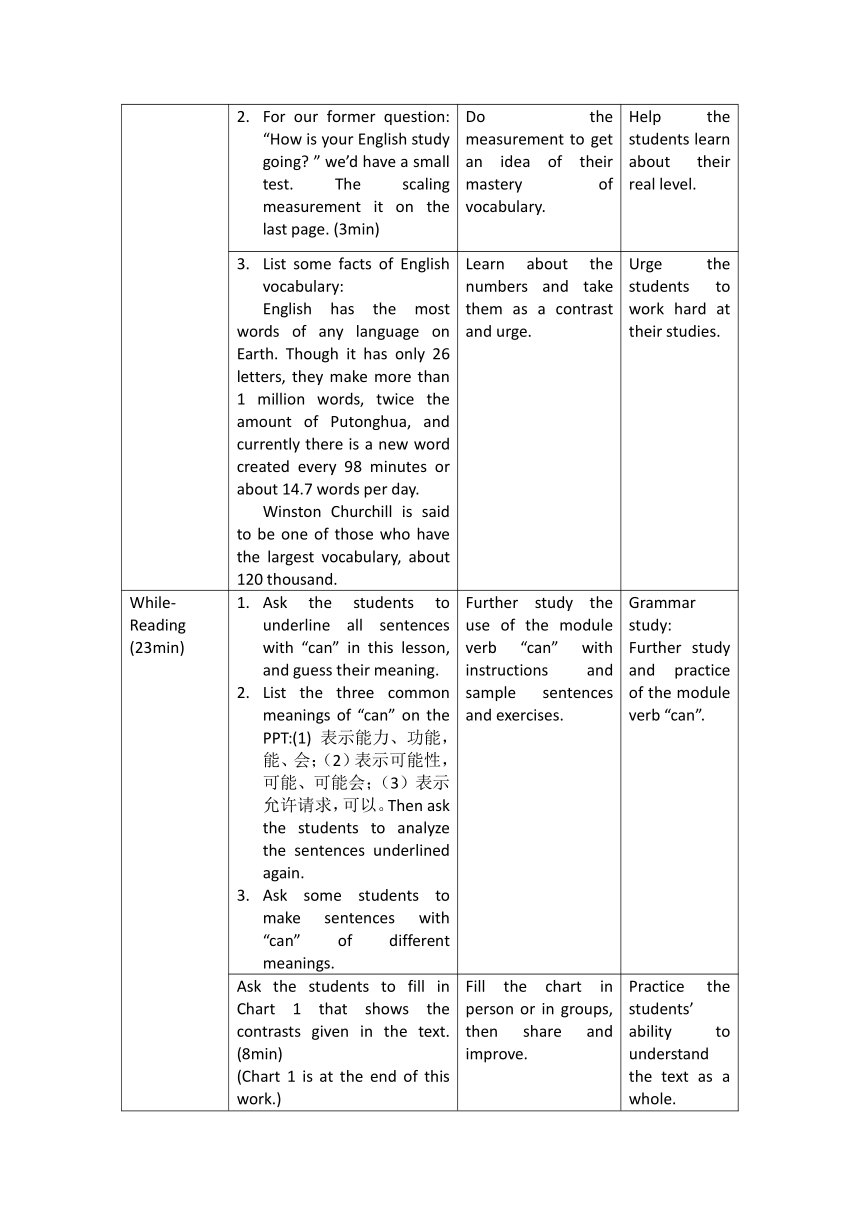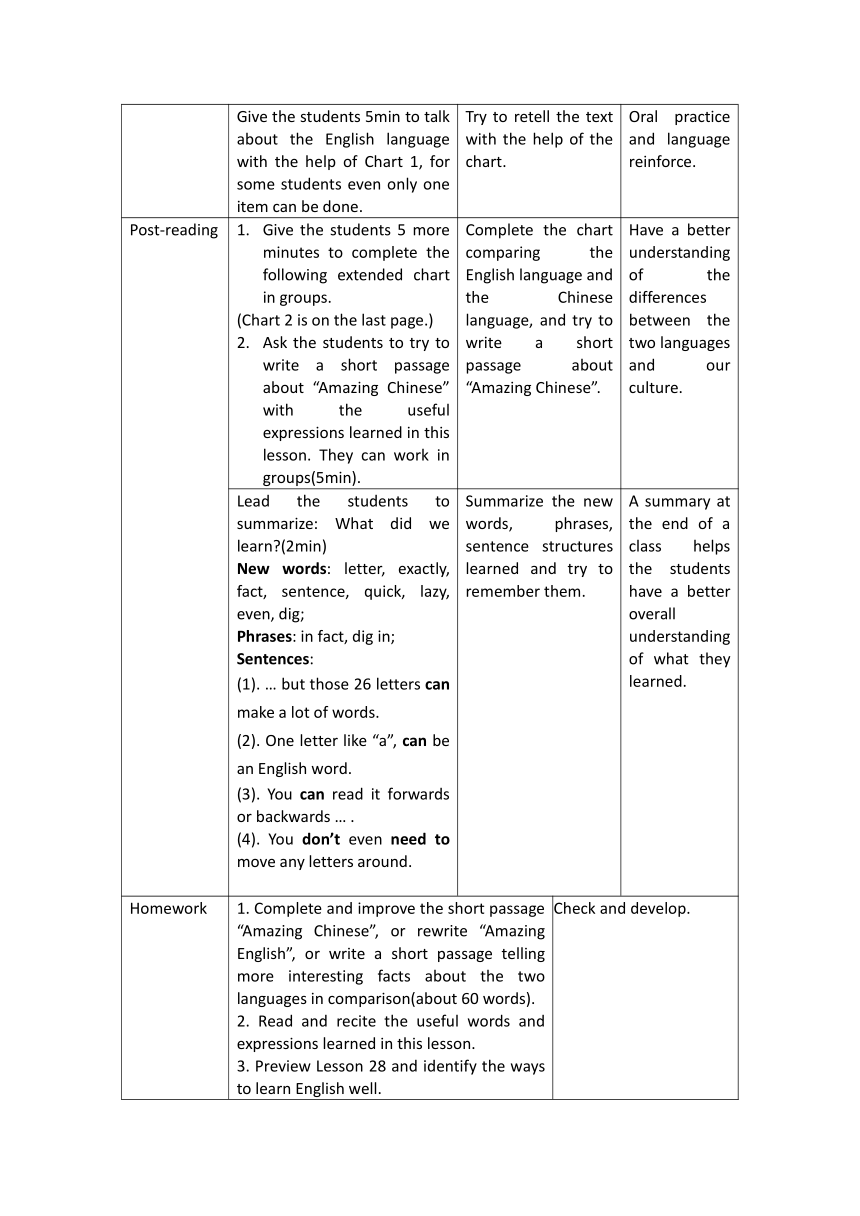Unit 5 I Love Learning English!Lesson 27 Amazing English 教案设计
文档属性
| 名称 | Unit 5 I Love Learning English!Lesson 27 Amazing English 教案设计 |

|
|
| 格式 | zip | ||
| 文件大小 | 35.4KB | ||
| 资源类型 | 教案 | ||
| 版本资源 | 冀教版 | ||
| 科目 | 英语 | ||
| 更新时间 | 2019-05-11 12:33:01 | ||
图片预览




文档简介
教学设计
基本信息 名称 Lesson 27: Amazing English
执教者 课时 1
所属教材目录 冀教版七年级下册
教材分析 本课取自冀教版七年级下册英语第五单元I Love Learning English。本单元主要介绍了常用而有效的英语学习方法、英语的趣味性和作用等方面。其中本课正是对英语语言趣味性的介绍。兴趣是最好的老师,当青少年学生觉得学习的对象有趣的时候,他们的学习积极性会被更好地调动起来。同时,本课重点练习情态动词can的三种用法。
学情分析 我班共有男生21人,女生16人。经过了初中半年多的英语学习之后,部分学生适应了初中英语课程的要求,成绩稳步提高,但是也有部分学生由于小学阶段的底子太薄,跟课吃力,甚至觉得英语无聊、无用。本课的编排可以从一定程度上缓解这种状况。教师在授课的过程中,不但要注意知识的传递和学习,更要注意教学方法的多样性和灵活性,以把所有学生的注意力都吸引到课堂学习上来,既可以让前者深入发展自己的能力,也可以帮助后者夯实基础,逐渐进步。
教学目标 知识与能力目标 掌握课标要求的四会词汇:letter, exactly, fact, sentence, quick, lazy, even, dig; 了解英语的一些常识和趣味小知识; 综合练习并掌握情态动词can 的基本应用: (1). … but those 26 letters can make a lot of words. (2). One letter like “a”, can be an English word. (3). You can read it forwards or backwards … .
过程与方法目标 通过中英文语言学习的对比,了解两种语言的差异,并得出结论学习语言要下功夫也要多说多用; 通过小组合作,提高合作意识,养成探索的习惯。
情感态度与价值观目标 在了解了英语语言的一些基本常识和趣味小知识之后,提高学习英语的兴趣和积极性。
文化目标 在对比中英文语言的过程中,进一步了解中国、了解世界。
教学重难点 重点 掌握四会词汇和重点短语、句型; 准确运用情态动词can的三种基本用法。
难点 熟练掌握并恰当运用情态动词can的三种基本用法; 用英语对比中英两种语言。
教学策略与 设计说明 单词教学和语法教学主要是以练代讲,课文理解主要采用任务型教学法,首先让学生分小组制作表格列明几组语言知识对比,然后通过中英文语言知识的对比拓展视野、练习有用的句型和表达方式。力图使各阶层的学生在轻松愉悦的环境下都能够学习和提高。
教学过程
教学环节 教师活动 学生活动 设计意图
Greetings Good morning, class! How is your English study going? Respond to the teacher’s greetings. Attract the students’ attention and lead in.
Pre-reading (10min) New words (1). Play the tape of the new words, ask the students to read after. Corrections are to be made if necessary. (2min) (2). Give the students 1min to read and recite the words.(1min) (3). Ask the students to complete the following passage with the words learned in correct forms without their books(3min): How many l_1__ are there in the English language? There are __2__(精确地) 26. Isn’t it easy to learn? some students find the English __3_(句子) interesting and they learn it _4__(迅速地), but some others __5_(甚至) can’t get the letters right. The f_6_ is that You should not be _7__(懒惰的) if you want to learn something and you should d__8_ in if you want to learn it well. (1). Read and correct the pronunciation. (2). Read and try to recite the words. (3). letters exactly sentences quickly even fact lazy dig Reading and exercises can help the students remember and learn to use the words better.
For our former question: “How is your English study going? ” we’d have a small test. The scaling measurement it on the last page. (3min) Do the measurement to get an idea of their mastery of vocabulary. Help the students learn about their real level.
List some facts of English vocabulary: English has the most words of any language on Earth. Though it has only 26 letters, they make more than 1 million words, twice the amount of Putonghua, and currently there is a new word created every 98 minutes or about 14.7 words per day. Winston Churchill is said to be one of those who have the largest vocabulary, about 120 thousand. Learn about the numbers and take them as a contrast and urge. Urge the students to work hard at their studies.
While- Reading (23min) Ask the students to underline all sentences with “can” in this lesson, and guess their meaning. List the three common meanings of “can” on the PPT:(1) 表示能力、功能,能、会;(2)表示可能性,可能、可能会;(3)表示允许请求,可以。Then ask the students to analyze the sentences underlined again. Ask some students to make sentences with “can” of different meanings. Further study the use of the module verb “can” with instructions and sample sentences and exercises. Grammar study: Further study and practice of the module verb “can”.
Ask the students to fill in Chart 1 that shows the contrasts given in the text. (8min) (Chart 1 is at the end of this work.) Fill the chart in person or in groups, then share and improve. Practice the students’ ability to understand the text as a whole.
Give the students 5min to talk about the English language with the help of Chart 1, for some students even only one item can be done. Try to retell the text with the help of the chart. Oral practice and language reinforce.
Post-reading Give the students 5 more minutes to complete the following extended chart in groups. (Chart 2 is on the last page.) Ask the students to try to write a short passage about “Amazing Chinese” with the useful expressions learned in this lesson. They can work in groups(5min). Complete the chart comparing the English language and the Chinese language, and try to write a short passage about “Amazing Chinese”. Have a better understanding of the differences between the two languages and our culture.
Lead the students to summarize: What did we learn?(2min) New words: letter, exactly, fact, sentence, quick, lazy, even, dig; Phrases: in fact, dig in; Sentences: (1). … but those 26 letters can make a lot of words. (2). One letter like “a”, can be an English word. (3). You can read it forwards or backwards … . (4). You don’t even need to move any letters around. Summarize the new words, phrases, sentence structures learned and try to remember them. A summary at the end of a class helps the students have a better overall understanding of what they learned.
Homework 1. Complete and improve the short passage “Amazing Chinese”, or rewrite “Amazing English”, or write a short passage telling more interesting facts about the two languages in comparison(about 60 words). 2. Read and recite the useful words and expressions learned in this lesson. 3. Preview Lesson 28 and identify the ways to learn English well. Check and develop.
Blackboard design Lesson New words: letter, exactly, fact, sentence, quick, lazy, even, dig; Phrases: in fact, dig in; Language points: don’t need to Grammar: can能力,可能性,允许
Conclusion We learned about some interesting facts about the English language, and talked something interesting about the Chinese language. The students are supposed to understand their differences as well as the differences between the two cultures, be able to use the new words and expressions and the module verb “can” correctly, and encouraged by the data to work harder by competing and helping each other.
教学反思 Pre-reading部分,单词环节以练代讲,帮助学生迅速掌握新单词的拼写和用法;然后用词汇量量表引起学生的兴趣,激发他们学习的热情和积极性。在while-reading部分,先是引导学生通过分析语法和文中例句学习情态动词can的三种基本用法,再通过自己造句、互相修改加深巩固;然后让学生们根据课文内容填表格,之后再根据表格复述课文内容,可以较好地帮助学生掌握课文内容。在post-reading部分,和学生一起在表一的基础上完成表二,帮助学生在对比中了解我们自己的语言和文化,然后给学生时间通过小组合作讨论,参考课文介绍迷人的汉语。在课后作业中要求学生继续改进自己的短文,同时也有预习和复习的要求。整节课的编排由易到难,既兼顾了知识性,也兼顾了趣味性,在了解英语的同时,也没有忽略汉语。符合学生认知水平和年龄特点。讲练结合,相互影响促进;形式多样,调动了学生多种感官同时参与。学生兴趣浓厚,学习积极主动。本节课教学目标设计较为合理,能够满足七年级中国学生发展的需要. 多种教学方法和多媒体的使用,较好带动了学生的积极性,使学生能够主动参与,积极配合;教学环节流程比较顺利,基本达到了教学预设和要求。但小组活动环节中,部分学生主动参与的比较少,主要是听别人发言,因为这部分内容对他们来说难度偏高。 在实际教学中,我还发现了一些自己的不足之处,今后一定多多学习,早做改进: ⑴. 个人的口语表达有些部分词汇较深,不利于七年级学生理解。 ⑵. 课堂上没有给学生充足的时间思考和表现,未能真正为水平参差不齐的学生创造适合不同层次的成功体验的机会。 ⑶. 在师的“导和辅”和生的“探和学”方面应继续加强改进。以后要创造性的教学,不但要让学生掌握课本的知识,还要会灵活运用、自主学习,将知识转化为技能。 (4). 对学生表现的积极反馈还不很够。 对于这节课的编排,我个人整体比较满意。如果再上这节课,我打算再调整一下节奏,多给学生一些时间做课前准备和研究,做更适当的引导,在做表二的时候可以先引导学生填一空、写一句,然后再让学生自己动手,以免学生无从下手。 从学生作业看,学生们对本节课的内容理解比较到位,也受到了一定的激励,但是对重点句型还不能随心所欲地实际使用,在将表二写成短文的过程中困难较大。造成这一现象的原因,一是因为课上教师的引导不够到位,二是因为学生的应变能力不够,不能够将所学联系实际。对此,我认为上课时加大相关练习应该能使之逐步有所改善。 听课老师们认为这节课总体比较令人满意,基本达到了新课标的要求。但是学生参与不够积极,建议想办法更好调动学生的热情和积极性。我认为说得非常中肯。所以在今后的教学中,我要更好地研究和吃透教材,针对不同的主题和目的,设计不同的教学方案,使我的课堂更加多样化、活起来,并进一步减少教师说和导的部分,加大学生练和学的部分,争取早日使之真正成为可持续发展的学生的课堂。
雅思考试词汇量测试量表
本量表是英语能力测评体系的一部分,主要用来测试学生的词汇量。词汇量测试共100道题,分为 6个级别。词汇量的计算方法:
Level 1答对的题目数×180 + Level 2答对的题目数×280 + Level 3答对的题目数×073 + Level 4答对的题目数×170 + Level 5答对的题目数×192 + Level 6答对的题目数×192=?(注:为了确保测试结果真实,凡是不确定的词汇请选择E。选项凭猜测的正确答案与真是词汇量无关系。)
Level 1
1.sure A.治疗 B.确信的 C.纯粹的 D.诱惑力 E.不认识
2.feather A.两者都不 B.天气 C.皮革 D.羽毛 E.不认识
3.poor A.贫穷的 B.门 C.地板 D.粗野的人 E.不认识
4.housework A.建房 B.工地 C.家务活 D.家庭作业 E.不认识
5.bread A.面包 B.面条 C.水果 D.甜点 E.不认识
6.sugar A.糖 B.醋 C.雪茄烟 D.饥饿 E.不认识
7.onto A.到…之上 B.到…里 C.此外 D.依然 E.不认识
8.manager A.饲料槽 B.乘客 C.邮递员 D.负责人 E.不认识
9.unit A.点 B.直到…才 C.单位 D.套装 E.不认识
10.ignore A.打鼾 B.忽视 C.点燃 D.可耻的 E.不认识
Level 2
11.financial A.最终的 B.财政的 C.结束 D.有限的 E.不认识
12.immigrant A.移民 B.流动的 C.不流动的 D.留鸟 E.不认识
13.roller A.酿酒厂 B.角色 C.冷却器 D.压路机 E.不认识
14.ambition A.环境 B.救护车 C.雄心 D.歧义的 E.不认识
15.hydrogen A.氦 B.氧 C.氢 D.氯 E.不认识
16.pine A.松树 B.葡萄酒 C.矿坑 D.进餐 E.不认识
17.surplus A.此外 B.超级的 C.惊喜的 D.剩余 E.不认识
18.fireman A.失业者 B.消防员 C.狙击手 D.纵火犯 E.不认识
19.outset A.摆放 B.外接装置 C.开始 D.安置 E.不认识
20.confusion A.迷惑 B.传播 C.灌输 D.大量 E.不认识
Level 3
21.reliance A.义务 B.信赖 C.宽慰 D.遗迹 E.不认识
22.collide A.碰撞 B.巧合 C.滑行 D.滑翔 E.不认识
23.sniff A.僵直的 B.东西 C.全体员工 D.嗅…味道 E.不认识
24.shaft A.工艺 B.草稿 C.箭杆 D.气味 E.不认识
25.cordial A.走廊 B.珊瑚 C.心脏的 D.真挚的 E.不认识
26.foul A.灵魂 B.污秽的 C.折叠 D.高尚的 E.不认识
27.idiot A.笨蛋 B.习语 C.闲混 D.偶像 E.不认识
28.inertia A.内部的 B.无活力 C.妨碍 D.间隔 E.不认识
29.stall A.安装 B.闲逛 C.凳子 D.畜栏 E.不认识
30.prone A.有倾向的 B.促进 C.宣布 D.敏捷的 E.不认识
31.shabby A.阴暗的 B.松弛的 C.褴褛的 D.贪婪的 E.不认识
32.exotic A.异国风味的 B.色情的 C.神经病的 D.外因的 E.不认识
33.cumulative A.刺激性 B.同化 C.清晰的 D.累积的 E.不认识
34.corpse A.庄稼 B.汇编 C.尸体 D.兵团 E.不认识
35.bishop A.平台 B.主教 C.鱼竿 D.商店 E.不认识
Level 4
36.explicit A.剥削的 B.驱逐的 C.明确的 D.附加的 E.不认识
37.dynamite A.动力的 B.炸药 C.氢弹 D.王朝 E.不认识
38.idealist A.理想主义者 B.现实主义者 C.唯物论者 D.虚无主义者 E.不认识
39.benevolent A.青少年 B.低下的 C.无知的 D.慈善的 E.不认识
40.downfall A.落后 B.垮台 C.谷底 D.市中心 E.不认识
41.extinct A.卓越的 B.不同的 C.明显的 D.灭绝的 E.不认识
42.reptile A.两栖动物 B.爬行动物 C.哺乳动物 D.脊椎动物 E.不认识
43.canteen A.食堂 B.瓦罐 C.糖果 D.腌制 E.不认识
44.hiker A.劫机犯 B.绑架者 C.徒步旅行者 D.登山者 E.不认识
45.fragile A.易碎的 B.易怒的 C.坦诚的 D.狂乱的 E.不认识
46.indefensible A.固若金汤的 B.不可原谅的 C.攻无不克的 D.胸怀坦荡的 E.不认识
47.lime A.石灰 B.四肢 C.羔羊 D.羊肉 E.不认识
48.adventurous A.广告的 B.新兴的 C.喜欢冒险的 D.原创的 E.不认识
49.drumstick A.鼓槌 B.指挥棒 C.支架 D.杠杆 E.不认识
50.sway A.席卷 B.摇晃 C.膨胀 D.打旋 E.不认识
51.respectful A.受人尊敬的 B.表示尊敬的 C.各自的 D.回顾的 E.不认识
52.alphabetical A.按年代顺序 B.断代的 C.逆序的 D.按字母顺序 E.不认识
53.scalar A.标量 B.矢量 C.位图 D.矢量图 E.不认识
54.ruthless A.违法的 B.残忍的 C.虚幻的 D.混乱的 E.不认识
55.paraphrase A.释义 B.比较 C.空头 D.跳伞 E.不认识
Level 5
56.ballast A.爆炸 B.虚夸 C.导火索 D.压舱物 E.不认识
57.corroborate A.搭配 B.合作 C.证实 D.详细说明 E.不认识
58.scatterbrain A.失忆的人 B.脑残的人 C.脑力激荡 D.注意力不集中的人 E.不认识
59.halter A.缰绳 B.制动装置 C.离合器 D.马蹄铁 E.不认识
60.heinous A.不合理的 B.令人发指的 C.可笑的 D.荒谬的 E.不认识
61.rearmament A.援军 B.解除武装 C.重置装备 D.后备力量 E.不认识
62.trek A.艰辛的路程 B.轨道 C.踪迹 D.路线 E.不认识
63.rasp A.竖琴 B.匆忙 C.粗锉刀 D.皮疹 E.不认识
64.barrister A.律师 B.障碍 C.美发师 D.炮药桶 E.不认识
65.testator A.测试人员 B.见证人 C.品酒师 D.立遗嘱的人 E.不认识
66.sappendicitis A.糖尿病 B.阑尾炎 C.附录 D.肺炎 E.不认识
67.quixotic A.顽固的 B.不实际的 C.愚忠的 D.势利的 E.不认识
68.maniac A.疯狂的 B.冷静的 C.残忍的 D.忧郁的 E.不认识
69.transposition A.运输 B.位置互换 C.传播 D.传染 E.不认识
70.stamina A.疯狂 B.绝望 C.苦难 D.耐力 E.不认识
71.woe A.誓言 B.悲哀 C.愤怒 D.哭泣 E.不认识
72.prod A.调查 B.序言 C.有倾向的 D.戳、刺 E.不认识
73.arrears A.贫欠款 B.后方 C.空地 D.面积 E.不认识
74.forefront A.最前方 B.额头 C.前足 D.前景 E.不认识
75.malign A.雄性的 B.高大的 C.有害的 D.无知的 E.不认识
Level 6
76.tauten A.淘气 B.拉紧 C.唆使 D.奚落 E.不认识
77.athletics A.抽象艺术 B.神学 C.美学 D.体育运动 E.不认识
78.volubility A.自愿 B.环绕 C.喋喋不休 D.旋转 E.不认识
79.fosse A.苔藓 B.护城河 C.浮渣 D.总的 E.不认识
80.decorticate A.装饰 B.煎药 C.漂泊 D.剥皮 E.不认识
81.permissive A.纵容的 B.迷失的 C.思念的 D.长久的 E.不认识
82.crochet A.蟋蟀 B.蚂蚱 C.钩针编制 D.螳螂 E.不认识
83.purblind A.漩涡的 B.愚钝的 C.流动的 D.默默的 E.不认识
84.remonstrance A.抗议 B.回忆 C.传奇 D.汇款 E.不认识
85.decrepit A.堕落的 B.收到 C.欺骗 D.破旧的 E.不认识
86.outmaneuver A.失控 B.以计谋胜过 C.操作失误 D.退出 E.不认识
87.tepefy A.使微热 B.为…典型 C.磁化 D.使钝化 E.不认识
88.apocrypha A.佛典 B.箴言 C.伪经 D.咒语 E.不认识
89.ringlet A.耳环 B.卷发 C.耳坠 D.耳垂儿 E.不认识
90.disinclined A.不屈的 B.执着的 C.虚伪的 D.不情愿的 E.不认识
91.nethermost A.恒温的 B.最下面的 C.热固性 D.冷血的 E.不认识
92.sibilant A.姐妹的 B.四肢的 C.齐名的 D.发滋滋声的 E.不认识
93.sheathe A.讲…差入鞘 B.犀牛皮 C.坚固的 D.坏死的 E.不认识
94.eugenic A.优生的 B.遗传的 C.引起过敏的 D.卤素的 E.不认识
95.lien A.外星的 B.扣押权 C.亚麻布 D.逗留 E.不认识
96.invective A.无礼 B.忤逆 C.刺激 D.咒骂 E.不认识
97.liberated A.手工的 B.危险的 C.放纵的 D.上方的 E.不认识
98.precipitation A.沉淀物 B.预期 C.预防 D.占据 E.不认识
99.innovation A.原始的 B.主动的 C.革新的 D.刺激性的 E.不认识
100.wrack A.残骸 B.没用的人 C.愤怒的 D.海藻 E.不认识
答案Keys:
001—010 B D A C A A A D C B 011—020 B A D C C A D B C A
021—030 B A D C D B A B D A 031—040 C A D C B C B A D B
041—050 D B A C A B A C A B 051—060 B D A A A D C D A B
061—070 C A C A D B B A B D 071—080 B D A A C B D C B D
081—090 A C B A D B A C B D 091—100 B D A A B D C A C D
常见考试的词汇要求(仅供参考):
中考 1500—1600 高考3000—3500 CET4 4000—4500 CET6/考研 5500—6000 TEM4 6000—7000 TEM8 10000—12000
Chart 1
1. number letters
words
2. length Shortest word/sentence
Longest word
3. a special sentence A sentence with all the 26 letters
4. special words A word reads the same forwards or backwards
A word has 10 words
Chart 2
English Chinese
number letters Initial/final consonants
words characters
length Shortest word Chinese characters are the shortest words in the world.
Longest word
Special sentences shortest Palindromes (回文诗) 春 景 诗(莺啼岸柳弄春晴夜月明)
With all the 26 letters proverbs
Special words A word reads the same forwards or backwards idioms
A word has 10 words in it.
基本信息 名称 Lesson 27: Amazing English
执教者 课时 1
所属教材目录 冀教版七年级下册
教材分析 本课取自冀教版七年级下册英语第五单元I Love Learning English。本单元主要介绍了常用而有效的英语学习方法、英语的趣味性和作用等方面。其中本课正是对英语语言趣味性的介绍。兴趣是最好的老师,当青少年学生觉得学习的对象有趣的时候,他们的学习积极性会被更好地调动起来。同时,本课重点练习情态动词can的三种用法。
学情分析 我班共有男生21人,女生16人。经过了初中半年多的英语学习之后,部分学生适应了初中英语课程的要求,成绩稳步提高,但是也有部分学生由于小学阶段的底子太薄,跟课吃力,甚至觉得英语无聊、无用。本课的编排可以从一定程度上缓解这种状况。教师在授课的过程中,不但要注意知识的传递和学习,更要注意教学方法的多样性和灵活性,以把所有学生的注意力都吸引到课堂学习上来,既可以让前者深入发展自己的能力,也可以帮助后者夯实基础,逐渐进步。
教学目标 知识与能力目标 掌握课标要求的四会词汇:letter, exactly, fact, sentence, quick, lazy, even, dig; 了解英语的一些常识和趣味小知识; 综合练习并掌握情态动词can 的基本应用: (1). … but those 26 letters can make a lot of words. (2). One letter like “a”, can be an English word. (3). You can read it forwards or backwards … .
过程与方法目标 通过中英文语言学习的对比,了解两种语言的差异,并得出结论学习语言要下功夫也要多说多用; 通过小组合作,提高合作意识,养成探索的习惯。
情感态度与价值观目标 在了解了英语语言的一些基本常识和趣味小知识之后,提高学习英语的兴趣和积极性。
文化目标 在对比中英文语言的过程中,进一步了解中国、了解世界。
教学重难点 重点 掌握四会词汇和重点短语、句型; 准确运用情态动词can的三种基本用法。
难点 熟练掌握并恰当运用情态动词can的三种基本用法; 用英语对比中英两种语言。
教学策略与 设计说明 单词教学和语法教学主要是以练代讲,课文理解主要采用任务型教学法,首先让学生分小组制作表格列明几组语言知识对比,然后通过中英文语言知识的对比拓展视野、练习有用的句型和表达方式。力图使各阶层的学生在轻松愉悦的环境下都能够学习和提高。
教学过程
教学环节 教师活动 学生活动 设计意图
Greetings Good morning, class! How is your English study going? Respond to the teacher’s greetings. Attract the students’ attention and lead in.
Pre-reading (10min) New words (1). Play the tape of the new words, ask the students to read after. Corrections are to be made if necessary. (2min) (2). Give the students 1min to read and recite the words.(1min) (3). Ask the students to complete the following passage with the words learned in correct forms without their books(3min): How many l_1__ are there in the English language? There are __2__(精确地) 26. Isn’t it easy to learn? some students find the English __3_(句子) interesting and they learn it _4__(迅速地), but some others __5_(甚至) can’t get the letters right. The f_6_ is that You should not be _7__(懒惰的) if you want to learn something and you should d__8_ in if you want to learn it well. (1). Read and correct the pronunciation. (2). Read and try to recite the words. (3). letters exactly sentences quickly even fact lazy dig Reading and exercises can help the students remember and learn to use the words better.
For our former question: “How is your English study going? ” we’d have a small test. The scaling measurement it on the last page. (3min) Do the measurement to get an idea of their mastery of vocabulary. Help the students learn about their real level.
List some facts of English vocabulary: English has the most words of any language on Earth. Though it has only 26 letters, they make more than 1 million words, twice the amount of Putonghua, and currently there is a new word created every 98 minutes or about 14.7 words per day. Winston Churchill is said to be one of those who have the largest vocabulary, about 120 thousand. Learn about the numbers and take them as a contrast and urge. Urge the students to work hard at their studies.
While- Reading (23min) Ask the students to underline all sentences with “can” in this lesson, and guess their meaning. List the three common meanings of “can” on the PPT:(1) 表示能力、功能,能、会;(2)表示可能性,可能、可能会;(3)表示允许请求,可以。Then ask the students to analyze the sentences underlined again. Ask some students to make sentences with “can” of different meanings. Further study the use of the module verb “can” with instructions and sample sentences and exercises. Grammar study: Further study and practice of the module verb “can”.
Ask the students to fill in Chart 1 that shows the contrasts given in the text. (8min) (Chart 1 is at the end of this work.) Fill the chart in person or in groups, then share and improve. Practice the students’ ability to understand the text as a whole.
Give the students 5min to talk about the English language with the help of Chart 1, for some students even only one item can be done. Try to retell the text with the help of the chart. Oral practice and language reinforce.
Post-reading Give the students 5 more minutes to complete the following extended chart in groups. (Chart 2 is on the last page.) Ask the students to try to write a short passage about “Amazing Chinese” with the useful expressions learned in this lesson. They can work in groups(5min). Complete the chart comparing the English language and the Chinese language, and try to write a short passage about “Amazing Chinese”. Have a better understanding of the differences between the two languages and our culture.
Lead the students to summarize: What did we learn?(2min) New words: letter, exactly, fact, sentence, quick, lazy, even, dig; Phrases: in fact, dig in; Sentences: (1). … but those 26 letters can make a lot of words. (2). One letter like “a”, can be an English word. (3). You can read it forwards or backwards … . (4). You don’t even need to move any letters around. Summarize the new words, phrases, sentence structures learned and try to remember them. A summary at the end of a class helps the students have a better overall understanding of what they learned.
Homework 1. Complete and improve the short passage “Amazing Chinese”, or rewrite “Amazing English”, or write a short passage telling more interesting facts about the two languages in comparison(about 60 words). 2. Read and recite the useful words and expressions learned in this lesson. 3. Preview Lesson 28 and identify the ways to learn English well. Check and develop.
Blackboard design Lesson New words: letter, exactly, fact, sentence, quick, lazy, even, dig; Phrases: in fact, dig in; Language points: don’t need to Grammar: can能力,可能性,允许
Conclusion We learned about some interesting facts about the English language, and talked something interesting about the Chinese language. The students are supposed to understand their differences as well as the differences between the two cultures, be able to use the new words and expressions and the module verb “can” correctly, and encouraged by the data to work harder by competing and helping each other.
教学反思 Pre-reading部分,单词环节以练代讲,帮助学生迅速掌握新单词的拼写和用法;然后用词汇量量表引起学生的兴趣,激发他们学习的热情和积极性。在while-reading部分,先是引导学生通过分析语法和文中例句学习情态动词can的三种基本用法,再通过自己造句、互相修改加深巩固;然后让学生们根据课文内容填表格,之后再根据表格复述课文内容,可以较好地帮助学生掌握课文内容。在post-reading部分,和学生一起在表一的基础上完成表二,帮助学生在对比中了解我们自己的语言和文化,然后给学生时间通过小组合作讨论,参考课文介绍迷人的汉语。在课后作业中要求学生继续改进自己的短文,同时也有预习和复习的要求。整节课的编排由易到难,既兼顾了知识性,也兼顾了趣味性,在了解英语的同时,也没有忽略汉语。符合学生认知水平和年龄特点。讲练结合,相互影响促进;形式多样,调动了学生多种感官同时参与。学生兴趣浓厚,学习积极主动。本节课教学目标设计较为合理,能够满足七年级中国学生发展的需要. 多种教学方法和多媒体的使用,较好带动了学生的积极性,使学生能够主动参与,积极配合;教学环节流程比较顺利,基本达到了教学预设和要求。但小组活动环节中,部分学生主动参与的比较少,主要是听别人发言,因为这部分内容对他们来说难度偏高。 在实际教学中,我还发现了一些自己的不足之处,今后一定多多学习,早做改进: ⑴. 个人的口语表达有些部分词汇较深,不利于七年级学生理解。 ⑵. 课堂上没有给学生充足的时间思考和表现,未能真正为水平参差不齐的学生创造适合不同层次的成功体验的机会。 ⑶. 在师的“导和辅”和生的“探和学”方面应继续加强改进。以后要创造性的教学,不但要让学生掌握课本的知识,还要会灵活运用、自主学习,将知识转化为技能。 (4). 对学生表现的积极反馈还不很够。 对于这节课的编排,我个人整体比较满意。如果再上这节课,我打算再调整一下节奏,多给学生一些时间做课前准备和研究,做更适当的引导,在做表二的时候可以先引导学生填一空、写一句,然后再让学生自己动手,以免学生无从下手。 从学生作业看,学生们对本节课的内容理解比较到位,也受到了一定的激励,但是对重点句型还不能随心所欲地实际使用,在将表二写成短文的过程中困难较大。造成这一现象的原因,一是因为课上教师的引导不够到位,二是因为学生的应变能力不够,不能够将所学联系实际。对此,我认为上课时加大相关练习应该能使之逐步有所改善。 听课老师们认为这节课总体比较令人满意,基本达到了新课标的要求。但是学生参与不够积极,建议想办法更好调动学生的热情和积极性。我认为说得非常中肯。所以在今后的教学中,我要更好地研究和吃透教材,针对不同的主题和目的,设计不同的教学方案,使我的课堂更加多样化、活起来,并进一步减少教师说和导的部分,加大学生练和学的部分,争取早日使之真正成为可持续发展的学生的课堂。
雅思考试词汇量测试量表
本量表是英语能力测评体系的一部分,主要用来测试学生的词汇量。词汇量测试共100道题,分为 6个级别。词汇量的计算方法:
Level 1答对的题目数×180 + Level 2答对的题目数×280 + Level 3答对的题目数×073 + Level 4答对的题目数×170 + Level 5答对的题目数×192 + Level 6答对的题目数×192=?(注:为了确保测试结果真实,凡是不确定的词汇请选择E。选项凭猜测的正确答案与真是词汇量无关系。)
Level 1
1.sure A.治疗 B.确信的 C.纯粹的 D.诱惑力 E.不认识
2.feather A.两者都不 B.天气 C.皮革 D.羽毛 E.不认识
3.poor A.贫穷的 B.门 C.地板 D.粗野的人 E.不认识
4.housework A.建房 B.工地 C.家务活 D.家庭作业 E.不认识
5.bread A.面包 B.面条 C.水果 D.甜点 E.不认识
6.sugar A.糖 B.醋 C.雪茄烟 D.饥饿 E.不认识
7.onto A.到…之上 B.到…里 C.此外 D.依然 E.不认识
8.manager A.饲料槽 B.乘客 C.邮递员 D.负责人 E.不认识
9.unit A.点 B.直到…才 C.单位 D.套装 E.不认识
10.ignore A.打鼾 B.忽视 C.点燃 D.可耻的 E.不认识
Level 2
11.financial A.最终的 B.财政的 C.结束 D.有限的 E.不认识
12.immigrant A.移民 B.流动的 C.不流动的 D.留鸟 E.不认识
13.roller A.酿酒厂 B.角色 C.冷却器 D.压路机 E.不认识
14.ambition A.环境 B.救护车 C.雄心 D.歧义的 E.不认识
15.hydrogen A.氦 B.氧 C.氢 D.氯 E.不认识
16.pine A.松树 B.葡萄酒 C.矿坑 D.进餐 E.不认识
17.surplus A.此外 B.超级的 C.惊喜的 D.剩余 E.不认识
18.fireman A.失业者 B.消防员 C.狙击手 D.纵火犯 E.不认识
19.outset A.摆放 B.外接装置 C.开始 D.安置 E.不认识
20.confusion A.迷惑 B.传播 C.灌输 D.大量 E.不认识
Level 3
21.reliance A.义务 B.信赖 C.宽慰 D.遗迹 E.不认识
22.collide A.碰撞 B.巧合 C.滑行 D.滑翔 E.不认识
23.sniff A.僵直的 B.东西 C.全体员工 D.嗅…味道 E.不认识
24.shaft A.工艺 B.草稿 C.箭杆 D.气味 E.不认识
25.cordial A.走廊 B.珊瑚 C.心脏的 D.真挚的 E.不认识
26.foul A.灵魂 B.污秽的 C.折叠 D.高尚的 E.不认识
27.idiot A.笨蛋 B.习语 C.闲混 D.偶像 E.不认识
28.inertia A.内部的 B.无活力 C.妨碍 D.间隔 E.不认识
29.stall A.安装 B.闲逛 C.凳子 D.畜栏 E.不认识
30.prone A.有倾向的 B.促进 C.宣布 D.敏捷的 E.不认识
31.shabby A.阴暗的 B.松弛的 C.褴褛的 D.贪婪的 E.不认识
32.exotic A.异国风味的 B.色情的 C.神经病的 D.外因的 E.不认识
33.cumulative A.刺激性 B.同化 C.清晰的 D.累积的 E.不认识
34.corpse A.庄稼 B.汇编 C.尸体 D.兵团 E.不认识
35.bishop A.平台 B.主教 C.鱼竿 D.商店 E.不认识
Level 4
36.explicit A.剥削的 B.驱逐的 C.明确的 D.附加的 E.不认识
37.dynamite A.动力的 B.炸药 C.氢弹 D.王朝 E.不认识
38.idealist A.理想主义者 B.现实主义者 C.唯物论者 D.虚无主义者 E.不认识
39.benevolent A.青少年 B.低下的 C.无知的 D.慈善的 E.不认识
40.downfall A.落后 B.垮台 C.谷底 D.市中心 E.不认识
41.extinct A.卓越的 B.不同的 C.明显的 D.灭绝的 E.不认识
42.reptile A.两栖动物 B.爬行动物 C.哺乳动物 D.脊椎动物 E.不认识
43.canteen A.食堂 B.瓦罐 C.糖果 D.腌制 E.不认识
44.hiker A.劫机犯 B.绑架者 C.徒步旅行者 D.登山者 E.不认识
45.fragile A.易碎的 B.易怒的 C.坦诚的 D.狂乱的 E.不认识
46.indefensible A.固若金汤的 B.不可原谅的 C.攻无不克的 D.胸怀坦荡的 E.不认识
47.lime A.石灰 B.四肢 C.羔羊 D.羊肉 E.不认识
48.adventurous A.广告的 B.新兴的 C.喜欢冒险的 D.原创的 E.不认识
49.drumstick A.鼓槌 B.指挥棒 C.支架 D.杠杆 E.不认识
50.sway A.席卷 B.摇晃 C.膨胀 D.打旋 E.不认识
51.respectful A.受人尊敬的 B.表示尊敬的 C.各自的 D.回顾的 E.不认识
52.alphabetical A.按年代顺序 B.断代的 C.逆序的 D.按字母顺序 E.不认识
53.scalar A.标量 B.矢量 C.位图 D.矢量图 E.不认识
54.ruthless A.违法的 B.残忍的 C.虚幻的 D.混乱的 E.不认识
55.paraphrase A.释义 B.比较 C.空头 D.跳伞 E.不认识
Level 5
56.ballast A.爆炸 B.虚夸 C.导火索 D.压舱物 E.不认识
57.corroborate A.搭配 B.合作 C.证实 D.详细说明 E.不认识
58.scatterbrain A.失忆的人 B.脑残的人 C.脑力激荡 D.注意力不集中的人 E.不认识
59.halter A.缰绳 B.制动装置 C.离合器 D.马蹄铁 E.不认识
60.heinous A.不合理的 B.令人发指的 C.可笑的 D.荒谬的 E.不认识
61.rearmament A.援军 B.解除武装 C.重置装备 D.后备力量 E.不认识
62.trek A.艰辛的路程 B.轨道 C.踪迹 D.路线 E.不认识
63.rasp A.竖琴 B.匆忙 C.粗锉刀 D.皮疹 E.不认识
64.barrister A.律师 B.障碍 C.美发师 D.炮药桶 E.不认识
65.testator A.测试人员 B.见证人 C.品酒师 D.立遗嘱的人 E.不认识
66.sappendicitis A.糖尿病 B.阑尾炎 C.附录 D.肺炎 E.不认识
67.quixotic A.顽固的 B.不实际的 C.愚忠的 D.势利的 E.不认识
68.maniac A.疯狂的 B.冷静的 C.残忍的 D.忧郁的 E.不认识
69.transposition A.运输 B.位置互换 C.传播 D.传染 E.不认识
70.stamina A.疯狂 B.绝望 C.苦难 D.耐力 E.不认识
71.woe A.誓言 B.悲哀 C.愤怒 D.哭泣 E.不认识
72.prod A.调查 B.序言 C.有倾向的 D.戳、刺 E.不认识
73.arrears A.贫欠款 B.后方 C.空地 D.面积 E.不认识
74.forefront A.最前方 B.额头 C.前足 D.前景 E.不认识
75.malign A.雄性的 B.高大的 C.有害的 D.无知的 E.不认识
Level 6
76.tauten A.淘气 B.拉紧 C.唆使 D.奚落 E.不认识
77.athletics A.抽象艺术 B.神学 C.美学 D.体育运动 E.不认识
78.volubility A.自愿 B.环绕 C.喋喋不休 D.旋转 E.不认识
79.fosse A.苔藓 B.护城河 C.浮渣 D.总的 E.不认识
80.decorticate A.装饰 B.煎药 C.漂泊 D.剥皮 E.不认识
81.permissive A.纵容的 B.迷失的 C.思念的 D.长久的 E.不认识
82.crochet A.蟋蟀 B.蚂蚱 C.钩针编制 D.螳螂 E.不认识
83.purblind A.漩涡的 B.愚钝的 C.流动的 D.默默的 E.不认识
84.remonstrance A.抗议 B.回忆 C.传奇 D.汇款 E.不认识
85.decrepit A.堕落的 B.收到 C.欺骗 D.破旧的 E.不认识
86.outmaneuver A.失控 B.以计谋胜过 C.操作失误 D.退出 E.不认识
87.tepefy A.使微热 B.为…典型 C.磁化 D.使钝化 E.不认识
88.apocrypha A.佛典 B.箴言 C.伪经 D.咒语 E.不认识
89.ringlet A.耳环 B.卷发 C.耳坠 D.耳垂儿 E.不认识
90.disinclined A.不屈的 B.执着的 C.虚伪的 D.不情愿的 E.不认识
91.nethermost A.恒温的 B.最下面的 C.热固性 D.冷血的 E.不认识
92.sibilant A.姐妹的 B.四肢的 C.齐名的 D.发滋滋声的 E.不认识
93.sheathe A.讲…差入鞘 B.犀牛皮 C.坚固的 D.坏死的 E.不认识
94.eugenic A.优生的 B.遗传的 C.引起过敏的 D.卤素的 E.不认识
95.lien A.外星的 B.扣押权 C.亚麻布 D.逗留 E.不认识
96.invective A.无礼 B.忤逆 C.刺激 D.咒骂 E.不认识
97.liberated A.手工的 B.危险的 C.放纵的 D.上方的 E.不认识
98.precipitation A.沉淀物 B.预期 C.预防 D.占据 E.不认识
99.innovation A.原始的 B.主动的 C.革新的 D.刺激性的 E.不认识
100.wrack A.残骸 B.没用的人 C.愤怒的 D.海藻 E.不认识
答案Keys:
001—010 B D A C A A A D C B 011—020 B A D C C A D B C A
021—030 B A D C D B A B D A 031—040 C A D C B C B A D B
041—050 D B A C A B A C A B 051—060 B D A A A D C D A B
061—070 C A C A D B B A B D 071—080 B D A A C B D C B D
081—090 A C B A D B A C B D 091—100 B D A A B D C A C D
常见考试的词汇要求(仅供参考):
中考 1500—1600 高考3000—3500 CET4 4000—4500 CET6/考研 5500—6000 TEM4 6000—7000 TEM8 10000—12000
Chart 1
1. number letters
words
2. length Shortest word/sentence
Longest word
3. a special sentence A sentence with all the 26 letters
4. special words A word reads the same forwards or backwards
A word has 10 words
Chart 2
English Chinese
number letters Initial/final consonants
words characters
length Shortest word Chinese characters are the shortest words in the world.
Longest word
Special sentences shortest Palindromes (回文诗) 春 景 诗(莺啼岸柳弄春晴夜月明)
With all the 26 letters proverbs
Special words A word reads the same forwards or backwards idioms
A word has 10 words in it.
同课章节目录
- Unit 1 A Trip to the Silk Road
- Lesson 1 A Trip to China
- Lesson 2 Meet You in Beijing
- Lesson 3 A Visit to Xi'an
- Lesson 4 A Visit to Lanzhou
- Lesson 5 Another Stop along the Silk Road
- Lesson 6 Jenny's Diary
- Unit 2 It's Show Time!
- Lesson 7 What's Your Project about?
- Lesson 8 Marco Polo and the Silk Road
- Lesson 9 Danny's School Project
- Lesson 10 Music and Dance
- Lesson 11 Food in China
- Lesson 12 A Blog about the Silk Road
- Unit 3 School Life
- Lesson 13 How Is School Going?
- Lesson 14 Jenny's School Life
- Lesson 15 Making a Difference
- Lesson 16 We Are with You!
- Lesson 17 School Science Fai
- Lesson 18 Teaching in China
- Unit 4 After-School Activities
- Lesson 19 A Dinner Date
- Lesson 20 Join Our Club!
- Lesson 21 What Is Your Club Type?
- Lesson 22 Big Plans for the Weekend
- Lesson 23 A Weekend with Grandma
- Lesson 24 How was Your Weekend?
- Unit 5 I Love Learning English!
- Lesson 25 A Phone Friend
- Lesson 26 Online Phone Calls
- Lesson 27 Amazing English
- Lesson 28 How Do I Learn English?
- Lesson 29 A Door to the World
- Lesson 30 Writing an E-mail in English
- Unit 6 Seasons
- Lesson 31 What Strange Weather!
- Lesson 32 I Can't Wait for Winter!
- Lesson 33 Kim's Favourite Season
- Lesson 34 Steven's Report
- Lesson 35 Surfing in Sydney
- Lesson 36 Spring in China
- Unit 7 Sports and Good Health
- Lesson 37 You Are What You Eat!
- Lesson 38 Stay Healthy!
- Lesson 39 Danny's Report
- Lesson 40 Move Your Body
- Lesson 41 Were People Healthy Then?
- Lesson 42 Know Yourself
- Unit 8 Summer Holiday Is Coming!
- Lesson 43 Have a Good Summer!
- Lesson 44 Volunteering in Summe
- Lesson 45 Baseball Season
- Lesson 46 Get Ready for Summer Holiday!
- Lesson 47 Summer Plans
- Lesson 48 Li Ming's Summer Holiday
